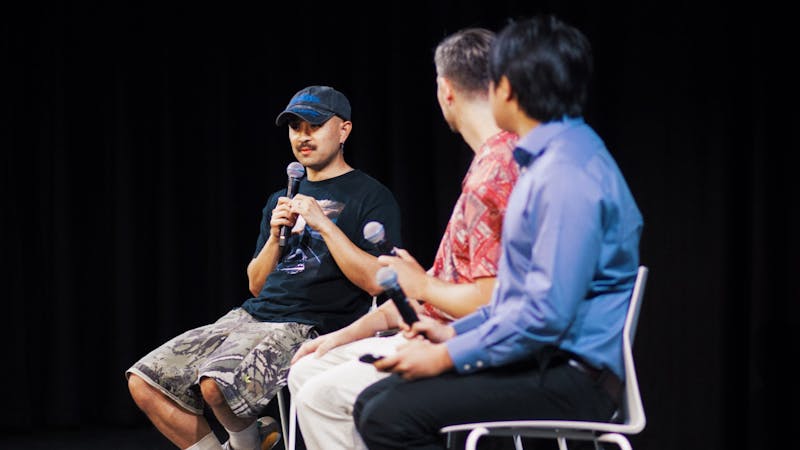Sophomores debut AI nutrition app Diagnos
Diagnos, an AI-backed nutrition-tracking app, launched in the Apple app store Sept. 24. The app, designed by Ifty Ahmed and Thun Silpsamrit, provides AI-based calorie and nutritional estimates based on users’ pictures of their food. The app also provides nutritional estimates of food on servery menus.
Ahmed and Silpsamrit said they had considered building a health-related app since January. One of their advisors, Roberta Anding, a lecturer of nutrition and health sciences, suggested focusing on nutrition. Ahmed and Silpsamrit began developing the app in June. They worked throughout the summer for as many as 14 hours a day to code the app, Ahmed said.
“It took [such] long, uncomfortable hours,” Ahmed, a Wiess College sophomore, said. “I’m living that life right now, fourteen hours every day on this.”
The team added Maya Zhang, a Jones College sophomore, in August to focus on business and marketing.
Diagnos’s AI works by identifying the size and diameter of the plate and the portion size of each food. It calculates the area, volume and density of each food item to find the associated calories and nutrient values.
“We have some faults in the data, and if we do not consider them, [image recognition] goes to 78% accuracy, which is … higher than a lot of competitors,” Ahmed said. Faulty data included images that were unclear to the AI due to stacked food items.
Ahmed said that the app uses prompts created by the team, which are then combined with other nutrition-tracking technologies and information from Housing and Dining.
“We do prompt engineering by ourselves, which is … the algorithm we made to train the AI,” Ahmed said. “We [use] the technology that provides other companies the nutrition tracking … So we combine both, and we use them to provide people more refined information … We are connected with Housing and Dining and we collect their information, and use them as a reference in our algorithm, [making it] more accurate.”
Ahmed said an advantage of Diagnos is accessibility, especially since their app targets college students.
“We [started] doing the algorithms … but not making users wait five minutes to log their food, which is [where some current technologies are], and also not asking them to pay $20 per month,” Ahmed said.
Silpsamrit, a McMurtry College sophomore, said that while the app includes features such as a weight tracker and a calorie counter, the team also included other metrics such as a Healthy Eating Index score.
“Another unique feature that I’m really proud of is the HEI score, because food is not just a number,” Silpsamrit said. “When you have a plate, it’s not just about how many calories, how many proteins, how many fats, how many carbs … HEI index is a really standardized index [to classify] the food into each category and how healthy [they are].”
Zhang said that the HEI tracker sets Diagnos apart from nutrition trackers that only focus on calories.
“[Calorie counting] can make people think that a food they’re eating is bad just because it’s high in calories, but we’re taking a different approach looking at food quality instead,” Zhang explained.
The team has also considered how Diagnos might harm people with disordered eating, Zhang said.
“We’re talking with the Wellbeing Center, and they actually referred us to the [Houston] Eating Recovery Center,” Zhang said. “Right now, we’re working on taking off the calorie amounts, because we know that’s a trigger, and seeing that number, a lot of people with disordered eating might feel adverse to the app.”
There are currently calorie and weight trackers that cannot be disabled, but the team said that they are planning for users to be able to toggle off these features.
The AI that gives advice within the Diagnos app is named ‘Dr. Daia.’
“We just think that putting the name doctor there would make it sound reliable,” said Silpsamrit. “We do not claim to have the same degree as a doctor. It’s not coming from us. It’s coming from the AI recommendations.”
According to Ahmed, Diagnos has seen success since its launch over a week ago.
“We have over 300 users within the first few weeks of launch,” Ahmed stated. “And our active user numbers are very high too … It’s getting up and up every day.”
The team plans to expand Diagnos to nearby Texas colleges and eventually go national. Ahmed said that they also want to raise revenue by bridging between companies who need data and individuals who can receive personalized products based on that data.
“The AI evolution is insanely progressing every day, and we need to find our spot so we can contribute to the change [in] society,” Ahmed said.
More from The Rice Thresher

Worth the wait: Andrew Thomas Huang practices patience
Andrew Thomas Huang says that patience is essential to being an artist. His proof? A film that has spent a decade in production, a career shaped by years in the music industry and a lifelong commitment to exploring queer identity and environmental themes — the kinds of stories, he said, that take time to tell right.

Andrew Thomas Huang puts visuals and identity to song
Houston is welcoming the Grammy-nominated figure behind the music videos of Björk and FKA twigs on June 27.

Live it up this summer with these Houston shows
Staying in Houston this summer and wondering how to make the most of your time? Fortunately, you're in luck, there's no shortage of amazing shows and performances happening around the city. From live music to ballet and everything in between, here are some events coming up this month and next!

Please note All comments are eligible for publication by The Rice Thresher.